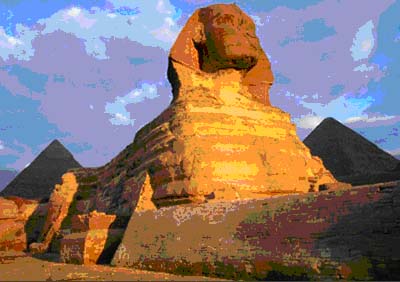The pyramid, which is built 146.5 meters tall with 2.3 million stones, each weighing 25 tons on average, is now only 137 meters in height. With a side length of 230 meters, it occupies an area of 5.3 hectares.
The conception of pyramids reflected the faith of the ancient Egyptians who believed in the sacredness of high mountains, vast deserts and long rivers. The pharaohs were advocated as the god of the nature that possessed the characteristics of the mountains, deserts and rivers. Therefore, the pyramids, as the tombs of the pharaohs, were built high, stable, heavy, indestructible, simple but magnificent, towering over other buildings nearby. The primitive pyramids and the river Nile are in harmony with each other in looking, creating a spectacle on the desert.
|

|
The Great Sphinx of Giza
|
East to the pyramid of Khafra, which is only second to Khufu in size, crouches a Sphinx. Facing the east, the statue seems to be saluting the rising sun every morning. When the Greek explorers went there thousands years ago, they couldn't help exclaiming at it, "Sphinx!"
In the ancient Greek mythology, the Sphinx was depicted as a single, unique creature with the body of a lion, the wings of an eagle, and the head of a human being. Its image, however, had come into being more than a thousand years before the birth of the Greek mythology. Together with the pyramids, the statues of the Sphinx signified the supreme power of the pharaohs and their eternal spirits after death.
This giant statue, which is sculpted out of a limestone hill, is 240 feet long and 66 feet tall. Sitting next to a majestic pyramid, it adds awe-inspiring mystery to the tomb of the pharaoh. The Great Sphinx is commonly accepted by Egyptologists to represent the likeness of King Khafra. Taking a certain animal as the ancestor of the god and worshiping it is a totemistic act. The ancient Egyptians carved the face of Khafra on the statue of a Sphinx to show the supreme authority of the pharaoh as the incarnation of the god.
